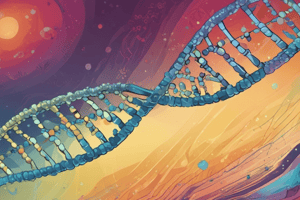Podcast
Questions and Answers
What is the purpose of introducing recombinant DNA molecules into bacteria?
What is the purpose of introducing recombinant DNA molecules into bacteria?
- To regulate gene expression in bacteria
- To produce multiple copies of a single gene (correct)
- To study the lysogenic infection cycle
- To understand phage-host interactions
What is the challenge in finding a specific gene among many clones?
What is the challenge in finding a specific gene among many clones?
- The need for bacteriophage vectors
- The complexity of gene regulation
- The requirement for DNA circularization
- The large number of genes in the human genome (correct)
What is the purpose of modifying the basic cloning procedure?
What is the purpose of modifying the basic cloning procedure?
- To understand phage-host interactions
- To ensure the correct gene is obtained (correct)
- To study the lysogenic infection cycle
- To increase the efficiency of gene regulation
What is the advantage of cloning a gene?
What is the advantage of cloning a gene?
What is the purpose of plating out bacteria?
What is the purpose of plating out bacteria?
What is the role of bacteriophage vectors in cloning?
What is the role of bacteriophage vectors in cloning?
What is the advantage of using techniques to identify the desired clone?
What is the advantage of using techniques to identify the desired clone?
What is the outcome of successfully cloning a gene?
What is the outcome of successfully cloning a gene?
What is the term used to describe the methods that involve gene cloning at their core?
What is the term used to describe the methods that involve gene cloning at their core?
What was the culmination of the rapid and efficient DNA sequencing techniques?
What was the culmination of the rapid and efficient DNA sequencing techniques?
What has enabled molecular biologists to understand how aberrations in gene activity can result in human diseases?
What has enabled molecular biologists to understand how aberrations in gene activity can result in human diseases?
What is the application of genes in production of proteins and other compounds needed in medicine and industrial processes?
What is the application of genes in production of proteins and other compounds needed in medicine and industrial processes?
Who is credited with inventing the polymerase chain reaction (PCR) in 1985?
Who is credited with inventing the polymerase chain reaction (PCR) in 1985?
What is the result of PCR on DNA analysis and molecular biology?
What is the result of PCR on DNA analysis and molecular biology?
What has been extended by PCR?
What has been extended by PCR?
What has been enabled by PCR in molecular biology?
What has been enabled by PCR in molecular biology?
What is the primary focus of the rewritten chapter in the Sixth Edition?
What is the primary focus of the rewritten chapter in the Sixth Edition?
What is the new technique introduced in the Sixth Edition for quantifying a particular DNA sequence?
What is the new technique introduced in the Sixth Edition for quantifying a particular DNA sequence?
What is the purpose of topoisomerase-based methods in Chapter 4?
What is the purpose of topoisomerase-based methods in Chapter 4?
How has the book evolved over the 25 years since the First Edition?
How has the book evolved over the 25 years since the First Edition?
What is the significance of the rewritten chapter on DNA sequencing?
What is the significance of the rewritten chapter on DNA sequencing?
What is the author's goal in writing this book?
What is the author's goal in writing this book?
What is the primary difference between the Sixth Edition and the First Edition?
What is the primary difference between the Sixth Edition and the First Edition?
What is not mentioned as a change made to the book over the 25 years since the First Edition?
What is not mentioned as a change made to the book over the 25 years since the First Edition?
Flashcards are hidden until you start studying
Study Notes
Genomics and Post-Genomics
- The Sixth Edition of the book includes new techniques, prompting a complete rewrite of DNA sequencing and genome sequencing information into a single chapter.
- A new chapter is devoted to post-sequencing methods used to study genomes.
PCR and Gene Cloning
- Real-time PCR is a means of quantifying the amount of a particular DNA sequence present in a preparation.
- Gene cloning and recombinant DNA technology sparked a great age of genetics, leading to rapid and efficient DNA sequencing techniques.
- Gene cloning led to procedures for studying gene regulation and understanding how aberrations in gene activity can result in human diseases like cancer.
History of Gene Cloning and PCR
- Gene cloning sparked a revolution in genetics in the 1980s.
- Kary Mullis invented the polymerase chain reaction (PCR) in 1985, which acts as a perfect complement to gene cloning.
- PCR has made easier many techniques that were possible but difficult to carry out when gene cloning was used on its own.
Gene Cloning Procedure
- Vectors and DNA fragments are used to construct recombinant DNA molecules.
- Recombinant DNA molecules are introduced into bacteria, which are then plated out.
- Each colony contains multiple copies of just one recombinant DNA molecule.
Gene Identification
- Strategies can be used to ensure that the correct gene can be obtained at the end of the cloning experiment.
- Modifications to the basic cloning procedure can select for cells containing the desired recombinant DNA molecule.
- Techniques can identify the desired clone from a mixture of different clones.
Studying That Suits You
Use AI to generate personalized quizzes and flashcards to suit your learning preferences.




